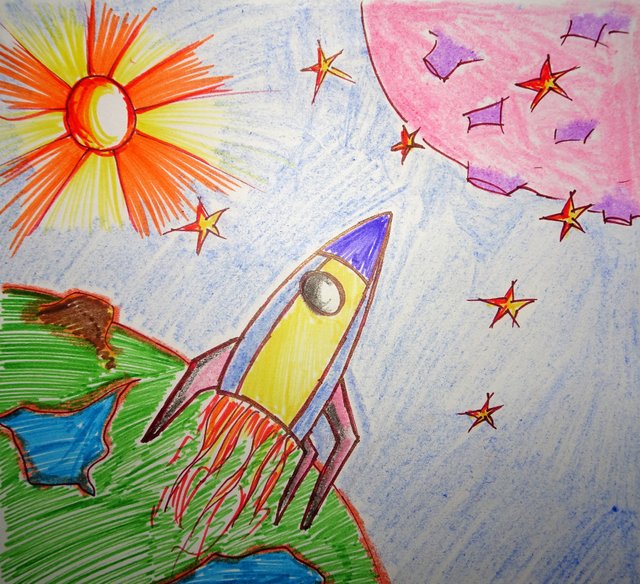How do Rocket Lift Off Happens & How do Rockets Move In Space, With Nothing To Push Off From?
Welcome friends, in this post we will look into the physics involved in the lift off of rockets. The law which allow them to fly beyond low earth orbit.
Some people argue that rockets can't function in the vacuum of space. The points they present are as follows:-
- According to them rockets push against the launch pad to move up.
- Further they say, thus since there is nothing to push against in space, they can't work in space.
First of all they are absolutely wrong. Rockets need launch pad to provide stable platform to support the weight of the structure. Without solid stable pad rocket will topple over, which would be disastrous.
So what exactly it is, you ask? Well the law behind rocket propulsion is ' The Law of Conservation of Momentum'. This law emerged from the Newton's Third Law of Motion which states:
For every action, there is an equal and opposite reaction
Let me break it down for you guys.
So, assume there are two objects, A and B going to collide with each other. Let mass of object A is m1 and mass of object B is m2. Now according to newton's third law, the force that object A exerts on object B is equal but opposite to the force that object B exerts on object A. By Newton's second law, this force is equal to the product of the mass and the acceleration of the objects, so the product of the mass and acceleration of object A is equal but opposite to the product between the mass and acceleration of object B. Let's assume velocity of abject A is v1 and velocity of object B is v2. Acceleration is the change of velocity divided by the time. Time is cancelled in the equation because in a collision, the forces act within the same time frame.
- a1 (acceleration of A) = v1/t
- a2 (acceleration of B) = v2/t
F1 = m1*a1
= m1*(v1/t)
F2 = m2*a2
= m2*(v2/t)
Now according to law of conservation of momentum,
F1 = -F2 ( here '-' sign denotes that F1 is acting in the opposite direction of F2 )
we get, m1*(v1/t) = -m2*(v2/t) , cancelling 't'
m1*v1 = -m2*v2
Momentum is defined as the product of mass and velocity, so finally the change in object A's momentum is equal to the opposite of the change in object B's momentum.
In the rocket system, the two objects are:
- rocket structure which include boosters, shuttle, etc.
- fuel rushing and burning out of the bottom of the rockets.
So, increase in the amount of fuel burning every second, will increase the speed of the rocket.
Rockets are needed to gain the escape velocity(i.e 25,020 mph) to fly past the low earth orbit. They are also needed to bring huge amounts of rocket propellant and oxidizer with them, which is required to burn fuel, because there in no atmosphere in space. Which increases the overall weight of the rocket. Thus, more fuel is needed to burn every second.
In simpler form, let's assume the mass of fuel burnt every second in a rocket system = m and the mass of rocket = M. Let the velocity of fuel rushing out = v and the velocity of rocket = V.
we get, m*v = -M*V
This is a very simplified solution, in reality all the above values are dynamic i.e they keep on changing with time, thus above equation becomes much more complicated. The mass of burning fuel(m) could increase with time. The mass of rocket(M) also changes with time as more and more fuel is burnt. Afterall fuel is stored inside the rocket, so more fuel is burnt, lighter the rocket becomes. Thus to compensate this, velocity of rocket(V) increases.
In the earth's atmosphere rocket has to work against the earth's gravity and air resistance. Thus, it requires large sum of fuel to burn while in the earth's atmosphere. After first stage ignition it sheds most of it's total weight in the form of boosters and most of the fuel. Only small probe or spacecraft reaches the space. Law of conservation of momentum also works in space as described above. But since in space, spacecraft doesn't have to work against gravity or air resistance that's why, less fuel is required to achieve high velocity. In space most of the fuel is required to slow down the spacecraft. Also in space, spacecrafts use celestial bodies for gravity assist to gain or shed velocity.
So, this is how rocket propulsion works.
Thank you for reading this post. If you like this post then you know what to do.
UPVOTE RESTEEM & FOLLOW to read more posts like this.
My previous posts:
https://steemit.com/science/@resurrection/why-won-t-parker-space-probe-melt
https://steemit.com/life/@resurrection/resurrecting-earth-and-all-life-it-supports

woow i dont understand anything :D
I can explain if you could tell me which part you do not understand.
I can explain if
You could tell me which part you
Do not understand.
- resurrection
I'm a bot. I detect haiku.
Nothing bro just leave it :D
Posted using Partiko Android
It perfectly follows every action has opposite reaction.
Yes, absolutely. Newton was perfectly right about this one. Though he didn't get the gravity 100% right.
your post get free upvote resteem and follow by @michealclauri
Get Free Upvotes and Follow + Resteem Click Here
muy bueno!
well, thanks
Congratulations @resurrection! You have completed the following achievement on Steemit and have been rewarded with new badge(s) :
Click on the badge to view your Board of Honor.
If you no longer want to receive notifications, reply to this comment with the word
STOP